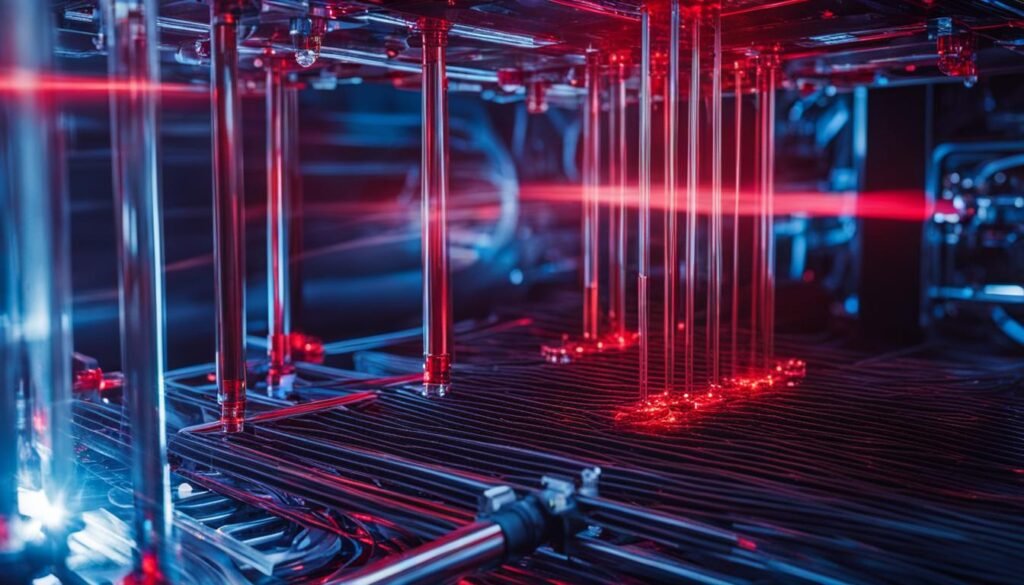Laser cooling and trapping is a groundbreaking technique in atomic physics and quantum mechanics that allows scientists to control the motion and temperature of neutral particles, such as atoms and ions, using laser light. By harnessing the power of laser cooling techniques, researchers have been able to manipulate these particles to achieve extremely low temperatures and precise control over their behavior. This comprehensive guide will provide an in-depth overview of laser cooling and trapping, exploring its historical background, basic principles, various cooling methods, and wide-ranging applications in scientific research.
Contents
Key Takeaways:
- Laser cooling and trapping is a technique used to manipulate the motion and temperature of neutral particles, such as atoms and ions.
- It is an essential tool in atomic physics and quantum mechanics, allowing for precise control and study of these particles.
- Various laser cooling techniques, such as Doppler cooling and optical molasses, are employed to achieve extreme low temperatures and control over particle behavior.
- Laser cooling has diverse applications in fields like high-resolution spectroscopy, ultracold gases, and quantum information technology.
- Suppliers like TOPTICA Photonics and MPB Communications play a crucial role in providing laser systems for laser cooling and trapping experiments.
Historical Development of Laser Cooling
The development of laser cooling and trapping techniques stems from the desire to control the motion of neutral particles, such as atoms and ions. While the manipulation of charged particles has yielded significant technological advancements, neutral particles presented a more challenging task. The advent of lasers expanded our capabilities, allowing us to cool atoms to extremely low temperatures and manipulate their motion on a microscopic scale. This groundbreaking achievement has been recognized by the Nobel Prize in Physics in 1997.
The history of laser cooling and trapping can be traced back to the early developments in laser technology. With lasers providing a precise and controlled source of light, researchers saw the potential to interact with atoms and ions in entirely new ways. By harnessing the forces exerted by laser light, scientists were able to slow down and trap neutral particles, opening up a realm of possibilities for scientific research.
“Laser cooling and trapping techniques have revolutionized our understanding of the behavior of atoms and ions. They have paved the way for advancements in various scientific fields and continue to contribute to our knowledge of the quantum world.”
Through years of experimentation and refinement, laser cooling techniques have evolved, leading to more efficient cooling methods and advancements in atom manipulation. These techniques involve using lasers to exchange energy and momentum with atoms, resulting in a reduction of their kinetic energy and temperature. From the early days of Doppler cooling to the development of more sophisticated techniques like optical molasses and Sisyphus cooling, researchers have made great strides in controlling and manipulating neutral particles.
| Laser Cooling Techniques | Description |
|---|---|
| Doppler cooling | Utilizes absorption and spontaneous emission of photons to cool atoms |
| Optical molasses | Uses multiple counter-propagating laser beams to trap and cool atoms |
| Sisyphus cooling | Relies on repeated absorption and emission of photons to cool atoms |
The historical development of laser cooling and trapping has not only deepened our understanding of atomic physics but has also led to breakthroughs in various scientific applications. From high-resolution spectroscopy to ultracold gases and quantum optics, laser cooling techniques have opened up new avenues of research and paved the way for advancements in quantum information technology and precise measurements of gravitational fields. The ongoing advancements in laser cooling and trapping promise a future filled with exciting discoveries and technological innovations.
Laser Cooling Techniques
Laser cooling techniques play a vital role in achieving the precise control and manipulation of neutral particles, such as atoms and ions. These techniques utilize various methods to exchange energy and momentum with the particles, resulting in their cooling and trapping. The following are some of the key laser cooling techniques used in scientific research:
Doppler Cooling
Doppler cooling is a widely employed laser cooling technique that relies on the absorption and subsequent spontaneous emission of photons by atoms. The photons transfer momentum to the atoms, causing them to lose kinetic energy and cool down. This technique is effective at reducing the temperature of atoms to the millikelvin range.
Optical Molasses
Optical molasses is another laser cooling technique that involves using a combination of counter-propagating laser beams. These laser beams create a standing-wave pattern that provides friction-like forces on the atoms, slowing down their motion and reducing their temperature further. Optical molasses is capable of achieving temperatures on the order of microkelvin.
Sisyphus Cooling
Sisyphus cooling is a laser cooling technique that combines Doppler cooling with the effects of light-induced atomic transitions. By carefully selecting the laser frequency and intensity, atoms can be trapped in an “optical molasses” potential, allowing for even lower temperatures to be reached.
Raman Laser Cooling, Sideband Cooling, VSCPT
Raman laser cooling, sideband cooling, and Velocity-Selective Coherent Population Trapping (VSCPT) are advanced laser cooling techniques that utilize laser-induced atomic transitions and quantum interference effects to achieve even lower temperatures. These techniques have enabled the cooling of atoms to the sub-microkelvin range, approaching the quantum limit.
Depolarization Cooling and Demagnetization Cooling
Depolarization cooling and demagnetization cooling are specialized laser cooling techniques used for specific types of atoms, such as alkali-metal atoms. These techniques rely on the manipulation of the atoms’ internal spin states and magnetic properties to achieve extremely low temperatures.
Overall, these laser cooling techniques provide scientists with powerful tools to control and manipulate atoms and ions at ultracold temperatures, opening up new opportunities for research in areas such as quantum physics, atomic physics, and precision measurement applications.
Principles of Laser Cooling

Laser cooling operates on the principles of light forces and momentum exchange between photons and atoms. When atoms are exposed to laser light, they can absorb photons and subsequently emit them spontaneously. This process transfers momentum from the photons to the atoms, resulting in a reduction of the atoms’ kinetic energy and a cooling effect. The absorption and emission of photons can create a friction force that directly cools the atoms or optically pump them into lower-energy quantum states.
The process of laser cooling can bring atoms to temperatures well below the Doppler limit, known as the recoil limit. At such low temperatures, the atoms enter the quantum regime, where their behavior is governed by quantum mechanics. Advanced techniques like velocity-selective coherent population trapping further enhance the cooling process by achieving sub-recoil temperatures, enabling even greater control over the atoms’ motion.
“The absorption and emission of photons play a crucial role in the laser cooling process, allowing us to manipulate and control the motion of atoms with incredible precision.”
In laser cooling, the choice of the optical frequency resonance is critical. By selecting the appropriate frequency, researchers can ensure efficient energy and momentum exchange between the laser light and the atoms. This resonance condition maximizes the cooling effect and minimizes unwanted heating effects. The precise control of the laser frequency is vital to achieving optimal laser cooling and trapping results.
Friction Force in Laser Cooling
A key concept in laser cooling is the friction force that arises due to the absorption and emission of photons. As the atoms absorb photons and subsequently emit them, the momentum exchange leads to a net deceleration of the atoms’ motion. This friction force can be utilized to cool the atoms and reduce their temperature. By carefully controlling the laser parameters, such as its intensity and frequency, scientists can manipulate the strength of the friction force and achieve the desired cooling effect.
The friction force is essential in laser cooling experiments as it allows for the efficient extraction of energy from the atoms, resulting in their cooling. This force can counteract the thermal motion of the atoms and bring them to much lower temperatures than would be achievable through traditional methods. The ability to reach such low temperatures opens up new possibilities for studying quantum phenomena and conducting experiments in the field of atomic physics.
Optical Pumping and Quantum Mechanical States
Optical pumping is another fundamental principle in laser cooling. It involves using laser light to manipulate the quantum mechanical state of atoms, leading to their cooling and control. By selectively exciting specific atomic energy levels, researchers can guide the atoms into lower-energy states, effectively reducing their kinetic energy and temperature.
This technique plays a crucial role in achieving ultracold temperatures in laser cooling experiments. Manipulating the quantum mechanical states of the atoms allows for the precise control of their motion and properties. As a result, researchers can study quantum phenomena, such as Bose-Einstein condensates, where a large number of atoms occupy the same quantum state. These ultracold systems offer unique insights into the behavior of matter in the quantum regime and have applications in various areas of scientific research.
Laser Cooling Applications
Laser cooling and trapping techniques have numerous applications across various fields of research. This section will explore some of the key applications of laser cooling, highlighting their significance and impact.
High-resolution spectroscopy:
Laser cooling plays a crucial role in high-resolution spectroscopy by eliminating Doppler broadening. This allows for precise measurements in frequency standards and optical clocks based on ultracold ions or atoms. The ability to control the motion and temperature of neutral particles through laser cooling enables researchers to achieve unprecedented levels of accuracy and precision in spectroscopic analysis.
Ultracold gases and Bose-Einstein condensation:
Laser cooling has revolutionized the study of ultracold gases, leading to the observation of phenomena such as Bose-Einstein condensation. By cooling atoms to extremely low temperatures, laser cooling techniques allow for the exploration of quantum mechanical effects on a macroscopic scale. This has opened up new possibilities for research in quantum optics, quantum information technology, and the development of quantum sensors and devices.
Precise measurement of gravitational fields:
Laser cooling has also found applications in the precise measurement of gravitational fields. By cooling atoms to ultracold temperatures and manipulating them with laser beams, researchers can create highly sensitive atomic interferometers capable of detecting minute changes in gravitational forces. This enables accurate measurements of gravitational fields and has potential applications in geodesy, navigation systems, and fundamental physics research.
Lithography and atomic fountains:
Laser cooling has had a significant impact on lithography, a key technology used in microfabrication and semiconductor manufacturing. By cooling atoms to ultracold temperatures, precise control over their motion and position can be achieved, allowing for the creation of atomic fountains used in atomic clocks and other precision measurements. Laser-cooled atoms can be used as ultra-precise references for timekeeping, making them invaluable in fields that require accurate measurements, such as metrology and fundamental physics research.
[Image Description: An image illustrating the diverse applications of laser cooling, including high-resolution spectroscopy, ultracold gases, Bose-Einstein condensation, precise measurement of gravitational fields, lithography, and atomic fountains.]
Suppliers of Laser Cooling and Trapping Systems

Laser cooling and trapping systems are essential tools for scientists conducting research in the field of cold atom manipulation. Several reputable suppliers cater to the diverse needs of the scientific community, offering state-of-the-art laser systems that enable precise control and manipulation of cold atoms. Let’s explore some of the prominent suppliers in this industry:
1. TOPTICA Photonics
TOPTICA Photonics is a leading provider of laser systems for a wide range of applications, including laser cooling and trapping. Their customized solutions are designed to meet the specific requirements of atom optics research. TOPTICA Photonics offers high-quality and flexible laser systems that enable scientists to achieve optimal performance and reliability in their experiments.
2. MPB Communications
MPB Communications specializes in high-power lasers for laser cooling and trapping applications. Their lasers are tailored for researchers who require precise control and manipulation of cold atoms. MPB Communications’ laser systems contribute to groundbreaking discoveries in the field by providing researchers with the tools necessary to study and understand the behavior of cold atoms.
3. NKT Photonics
NKT Photonics offers laser systems ideal for resonant laser cooling, delivering precise wavelengths required for specific atomic or ion transitions. NKT Photonics’ lasers are designed to optimize the efficiency of laser cooling experiments, providing researchers with the ability to achieve lower temperatures and enhanced control over the motion of cold atoms.
4. Schäfter + Kirchhoff
Schäfter + Kirchhoff specializes in providing fiber port clusters that are essential for atom trapping and control. Their products play a crucial role in laser cooling and trapping experiments, ensuring stable and reliable performance. By offering high-quality fiber port clusters, Schäfter + Kirchhoff supports researchers in their pursuit of advancing cold atom manipulation techniques.
These suppliers contribute significantly to the advancement of laser cooling and trapping techniques by delivering cutting-edge laser systems and related equipment to research laboratories worldwide. Through their innovations, scientists can continue to push the boundaries of atomic physics and quantum mechanics, leading to new discoveries and future technological advancements.
Conclusion
Laser Cooling and Trapping: A Comprehensive Guide has provided a detailed exploration of this groundbreaking technique that has revolutionized our understanding and control of neutral particles. From its historical development to the basic principles and laser cooling techniques, this comprehensive guide has shed light on the immense potential and wide-ranging applications of laser cooling and trapping in atomic physics and quantum mechanics.
As we delve deeper into the fascinating world of laser cooling and trapping, it is evident that its impact extends beyond scientific research. The precise manipulation of atoms and ions opens doors to scientific applications such as high-resolution spectroscopy, ultracold gases, Bose-Einstein condensation, quantum optics, and quantum information technology. Furthermore, laser cooling and trapping have found practical use in precise gravitational field measurements, lithography, and atomic clocks.
The future of laser cooling and trapping holds great promise. Continued advancements in laser technology and the development of new cooling techniques will further enhance our understanding of atomic physics and quantum mechanics. As scientists and researchers push the boundaries of what is possible, laser cooling and trapping will undoubtedly continue to shape scientific advancements and pave the way for new technological innovations in the years to come.
FAQ
What is laser cooling and trapping?
Laser cooling and trapping is a groundbreaking technique that allows scientists to control the motion and temperature of neutral particles, such as atoms and ions, using laser light.
How does laser cooling work?
Laser cooling techniques involve the use of specific light fields or pulses to exchange energy and momentum with atoms, resulting in a reduction of their kinetic energy and temperature.
What are some common laser cooling techniques?
Some common laser cooling techniques include Doppler cooling, optical molasses, Sisyphus cooling, Raman laser cooling, sideband cooling, VSCPT, depolarization cooling, and demagnetization cooling.
What are the principles of laser cooling?
Laser cooling operates on the principles of light forces and momentum exchange between photons and atoms. It involves the absorption and subsequent spontaneous emission of photons, leading to the transfer of momentum and cooling of the atoms.
What are the applications of laser cooling?
Laser cooling has numerous applications in high-resolution spectroscopy, the study of ultracold gases and phenomena like Bose-Einstein condensation, quantum optics, quantum information technology, precise measurement of gravitational fields, lithography, and atomic fountains used for atomic clocks and precision measurements.
Are there any suppliers of laser cooling and trapping systems?
Yes, several companies specialize in supplying laser cooling and trapping systems for scientific research. Some examples include TOPTICA Photonics, MPB Communications, NKT Photonics, and Schäfter + Kirchhoff.



